An Investigation of Mechanical Properties of Concrete by Applying Sand Coating on Recycled High-Density Polyethylene (HDPE) and Electronic-Wastes (E-Wastes) Used as a Partial Replacement of Natural Coarse Aggregates
Abstract
:1. Introduction
2. Literature Review
3. Materials and Methods
4. Development of Experimental Setup
5. Testing Procedures on Materials
6. Results and Discussion
6.1. Workability
6.2. Mechanical Properties
6.2.1. Compressive Strength
6.2.2. Split Tensile Strength
6.2.3. Flexural Strength
7. Statistical Correlation among Various HDPE and E-Wastes Concrete Properties
8. Conclusions and Recommendations
Author Contributions
Funding
Institutional Review Board Statement
Informed Consent Statement
Data Availability Statement
Conflicts of Interest
Abbreviations
| NCA | Natural coarse aggregates |
| HDPE | High density Polyethylene |
| E-wastes | Electronic wastes |
| PET | Polyethylene Terephthalate (in Introduction paragraph) |
| SP-675 | Super plasticizer 675 |
References
- Suchithra, S.; Kumar, M.; Indu, V.S. Study on replacement of coarse aggregate by E- waste in concrete. Int. J. Tech. Res. Appl. 2015, 3, 266–270. [Google Scholar]
- Paul, S.C.; Šavija, B.; Babafemi, A.J. A comprehensive review on mechanical and durability properties of cement-based materials containing waste recycled glass. J. Clean. Prod. 2018, 198, 891–906. [Google Scholar] [CrossRef]
- Ragaert, K.; Delva, L.; Van Geem, K. Mechanical and chemical recycling of solid plastic waste. Waste Manag. 2017, 69, 24–58. [Google Scholar] [CrossRef] [PubMed]
- Alagusankareswari, K.; Kumar, S.S.; Vignesh, K.B.; Abdul Hameed Niyas, K. An experimental study on E-waste concrete. Indian J. Sci. Technol. 2016, 9, 3–7. [Google Scholar] [CrossRef]
- Manikandan, M.; Arul Prakash, D.; Manikandan, P. Experimental study on E—waste concrete and comparing with conventional concrete. J. Ind. Pollut. Contr. 2017, 33, 1490–1495. [Google Scholar]
- Manjunath, B.T.A. Partial replacement of E-plastic waste as coarse-aggregate in concrete. Procedia Environ. Sci. 2016, 35, 731–739. [Google Scholar] [CrossRef]
- Prasanna, P.K.; Rao, M.K. Strength variations in concrete by using E-waste as coarse aggregate. Int. J. Educ. Appl. Res. 2014, 4, 82–84. [Google Scholar]
- Nadhim, S.; Shree, P.N.; Kumar, G.P. A comparative study on concrete containing E- plastic waste and fly ash concrete with conventional concrete. Parishodhana House J. Sci. Technol. 2018, 6, 31–38. [Google Scholar] [CrossRef]
- Habib, M.Z.; Alom, M.M.; Hoque, M.M. Concrete production using recycled waste plastic as aggregate. J. Civil. Eng. 2017, 45, 11–17. [Google Scholar]
- Alqahtani, F.K.; Ghataora, G.; Khan, M.I.; Dirar, S.; Kioul, A.; Al-Otaibi, M. Lightweight Concrete Containing Recycled Plastic Aggregates. In Proceedings of the International Conference on Electromechanical Control Technology and Transportation (ICECTT 2015), Coimbatore, India, 5–7 March 2015; pp. 527–533. [Google Scholar]
- Ali, B.; Qureshi, L.A.; Shah, S.H.A.; Rehman, S.U.; Hussain, I.; Iqbal, M. A step towards durable, ductile and sustainable concrete: Simultaneous incorporation of recycled aggregates, glass fiber and fly ash. Construct. Build. Mater. 2020, 251, 118980. [Google Scholar] [CrossRef]
- Kurad, R.; Silvestre, J.D.; de Brito, J.; Ahmed, H. Effect of incorporation of high volume of recycled concrete aggregates and fly ash on the strength and global warming potential of concrete. J. Clean. Prod. 2017, 166, 485–502. [Google Scholar] [CrossRef]
- Bahij, S.; Omary, S.; Feugeas, F.; Faqiri, A. Fresh and hardened properties of concrete containing different forms of plastic waste—A review. Waste Manag. 2020, 113, 157–175. [Google Scholar] [CrossRef]
- Ahmad, A.; Adil, M.; Khalil, A.; Rahman, M. Mechanical properties and durability of board concrete blocks prepared from recycled cardboard. J. Build. Eng. 2021, 33, 101644. [Google Scholar] [CrossRef]
- De la Colina Martínez, A.L.; Martínez Barrera, G.; Barrera Díaz, C.E.; Ávila Córdoba, L.I.; UreñaNúñez, F.; Delgado Hernández, D.J. Recycled polycarbonate from electronic waste and its use in concrete: Effect of irradiation. Construct. Build. Mater. 2019, 201, 778–785. [Google Scholar] [CrossRef]
- Tamanna, N.; Tuladhar, R.; Sivakugan, N. Performance of recycled waste glass sand as partial replacement of sand in concrete. Construct. Build. Mater. 2020, 239, 117804. [Google Scholar] [CrossRef]
- Coppolaa, L.; Karab, P.; Lorenzia, S. Concrete manufactured with crushed asphalt as partial replacement of natural aggregates. Mater. Construcción 2016, 66, 324. [Google Scholar] [CrossRef] [Green Version]
- Petrounias, P.; Giannakopoulou, P.P.; Rogkala, A.; Lampropoulou, P.; Tsikouras, B.; Rigopoulos, I.; Hatzipanagiotou, K. Petrographic and Mechanical Characteristics of Concrete Produced by Different Type of Recycled materials. Geosciences 2019, 9, 264. [Google Scholar] [CrossRef] [Green Version]
- Petrounias, P.; Rogkala, A.; Giannakopoulou, P.P.; Lampropoulou, P.; Xanthopoulou, V.; Koutsovitis, P.; Koukouzas, N.; Lagogiannis, I.; Lykokanellos, G.; Golfinopoulos, A. An Innovative Experimental Petrographic Study of Concrete Produced by Animal bones and human hair fibers. Sustainability 2021, 13, 8107. [Google Scholar] [CrossRef]
- Jaivignesh, B.; Sofi, A. Study on Mechanical Properties of Concrete Using Plastic Waste as an Aggregate. IOP Conf. Ser. Earth Environ. Sci. 2017, 80, 012016. [Google Scholar] [CrossRef]
- Ismail, Z.Z.; Al-Hashmi, E.A. Use of waste plastic in concrete mixture as aggregate replacement. Sci. Direct Waste Manag. 2008, 28, 2041–2047. [Google Scholar] [CrossRef]
- Rathore, V.; Rawat, A. Effective Utilization of Electronic Waste in Concrete Mixture as a Partial Replacement to Coarse Aggregates. AIPConf. Proc. 2019, 2158, 020037. [Google Scholar]
- Nursyamsi, N.; Indrawan, I.; Theresa, V. Effect of HDPE plastic waste towards batako properties. IOP Conf. Ser. Mater. Sci. Eng. 2018, 309, 012013. [Google Scholar] [CrossRef]
- Amalu. R.G.; Ashraf, A.; Hashim, M.; Rejith, K.U.; Vijitha, V. Use of waste plastic as fine aggregate substitute in concrete. Int. J.Sci. Eng. Res. 2016, 7, 172–177. [Google Scholar]
- Jibrael, M.A.; Peter, F. Strength and Behavior of Concrete Contains Waste Plastic. J. Ecosyst. Ecography 2016, 6, 2–5. [Google Scholar] [CrossRef]
- Ullah, Z.; Qureshi, M.I.; Ahmad, A.; Khan, S.U.; Javaid, M.F. An Experimental study on Mechanical and durability properties assessment of E-waste concete. J. Build. Eng. 2021, 38, 102177. [Google Scholar] [CrossRef]
- Ali, K.; Qureshi, M.I.; Saleem, S.; Khan, S.U. Effect of waste plastic Electronic waste and silica fume on mechanical properties and thermal performance of concrete. Constr. Build. Mater. 2021, 285, 122952. [Google Scholar] [CrossRef]
- Singh, S.S.; Patel, A. Utilization of E-Waste in High Strength Cement Concrete. IJSRD—Int. J. Sci. Res. Dev. 2015, 3, 691–694. [Google Scholar]
- Guptaa, B.K.; Singh, S. To Study the feasibility of Course and Fine plastic Aggregates in Concrete. Int. J. Appl. Eng. Res. 2018, 13, 5815–5822. [Google Scholar]
- Ahmed, Z.; Qureshi, M.I. Influential assessment of macro synthetic fibers on mechanical properties of concrete containing e- waste coarse aggregates. In Proceedings of the 3rd Conference on Sustainability in Civil Engineering (CSCE’21), Islamabad, Pakistan, 26–27 November 2020; Department of Civil Engineering Capital University of Science and Technology: Islamabad, Pakistan, 2021; pp. 1–7. [Google Scholar]
- Rai, B.; Rushad, S.T.; Kr, B.; Duggal, S.K. Study of Waste Plastic Mix Concrete with Plasticizer. Int. Sch. Res. Netw. ISRN CivilEng. 2012, 2012, 469272. [Google Scholar] [CrossRef] [Green Version]
- Lee, Z.H.; Paul, S.C.; Kong, S.Y.; Susilawati, S.; Yang, X. Modification of waste aggregate PET for improving the concrete properties. Adv. Civ. Eng. 2019, 2019, 6942052. [Google Scholar] [CrossRef]
- ASTM C143/C143M.; Standard Test Method for Slump of Hydraulic-Cement Concrete, ASTM Stand. ASTM International: West Conshohocken, PA, USA, 2015.
- ASTM C39/C39M.; Standard Test Method for Compressive Strength of Cylindrical Concrete Specimens. ASTM International: West Conshohocken, PA, USA, 2018.
- ASTM C496/C496M-17; Standard Test Method for Splitting Tensile Strength of Cylindrical Concrete Specimens. ASTM International: West Conshohocken, PA, USA, 2017.
- ASTM C293; Standard Test Method for Flexural Strength of Concrete (Using Simple Beam with (Center-Point Loading). ASTM International: West Conshohocken, PA, USA, 2016.
- Angiolilli, M.; Gregori, A.; Vailati, M. Lime-Based Mortar Reinforced by Randomly Oriented Short Fibers for the Retrofitting of the Historical Masonry Structure. Materials 2020, 13, 3462. [Google Scholar] [CrossRef]
- Vailati, M.; Mercuri, M.; Angiolilli, M.; Gregori, A. Natural-Fibrous Lime-Based Mortar for the Rapid Retrofitting of Heritage Masonry Buildings. Fibers 2021, 9, 68. [Google Scholar] [CrossRef]
- Osei, D.Y. Experimental investigation of recycled plastics used as aggregates in concrete. Int. J. Civ. Eng. Res. 2014, 3, 168–174. [Google Scholar]
- Javaid, M.F.; Qureshi, M.I.; Saleem, S. Effect of temperature on behavior of concrete with E-waste as partial replacement of aggregates. In Proceedings of the 3rd Pak-Turk International Conference Proceedings (Local)At: Ghulam Ishaq Khan Institute of Engineering Sciences & Technology, Topi, Pakistan, 9–10 June 2020; pp. 1–8. [Google Scholar]
- Koehler, E.P.; Fowler, D.W. Measuring the workability of high fines concrete for aggregate. Int. Cent. Aggreg. Res. 2003. [Google Scholar] [CrossRef]
- Islam, M.J.; Meherier, M.S.; Islam, A.K.M.R. Effects of waste PET as coarse aggregate on the fresh and harden properties of concrete. Constr. Build. Mater. 2016, 125, 946–951. [Google Scholar] [CrossRef]
- Pezzi, L.; De Luca, P.A.; Vuono, D.; Chiappetta, F.; Nastro, A. Concrete products with waste’s plastic material (bottle, glass, plate). In Materials Science Forum; Trans Tech Publications Ltd.: Bäch, Switzerland, 2006; p. 1753. [Google Scholar]
- Hannawi, K.; Kamali-Bernard, S.; Prince, W. Physical and mechanical properties of mortars containing PET and PC waste aggregates. Waste Manag. 2010, 30, 2312–2320. [Google Scholar] [CrossRef]
- Kou, S.C.; Lee, G.; Poon, C.S.; Lai, W.L. Properties of lightweight aggregate concrete prepared with PVC granules derived from scraped PVC pipes. Waste Manag. 2009, 29, 621–628. [Google Scholar] [CrossRef]
- Babafemi, A.J.; Šavija, B.; Paul, S.C.; Anggraini, V. Engineering properties of concrete with waste recycled plastic: A review. Sustainability 2018, 10, 3875. [Google Scholar] [CrossRef] [Green Version]
- Lakshmi, R.; Nagan, S. Investigations on durability characteristics of E-plastic waste incorporated concrete. Asian J. Civ. Eng. (Build. Hous.) 2011, 12, 773–787. [Google Scholar]
- Mathew, P.; Varghese, S.; Paul, T.; Varghese, E. Recycled plastics as coarse aggregate for structural concrete. Int. J. Innov. Res. Sci. Eng. Technol. 2013, 2, 687–690. [Google Scholar]
- Tamang, L.W.T.; Wangmo, T.; Darjay, K.T.; Phuntsho, K.S.; Namgyal, P.; Wangchuk, U. Use of plastics in concrete as coarse aggregate. Int. J. Educ. Appl. Res. 2017, 7, 9–13. [Google Scholar]
- Azhdarpour, A.M.; Nikoudel, M.R.; Taheri, M. The effect of using polyethylene terephthalate particles on physical and strength-related properties of concrete; a laboratory evaluation. Constr. Build. Mater. 2016, 109, 55–62. [Google Scholar] [CrossRef]
- Rame zanian pour, A.A.; Bahrami Jovein, H. Influence of metakaolinas supplementary cementing material on strength and durability of concretes. Constr. Build. Mater. 2012, 30, 470–479. [Google Scholar] [CrossRef]
- Meddah, A.; Beddar, M.; Bali, A. Use of shredded rubber tire aggregates for roller compacted concrete pavement. J. Clean. Prod. 2014, 72, 187–192. [Google Scholar] [CrossRef]
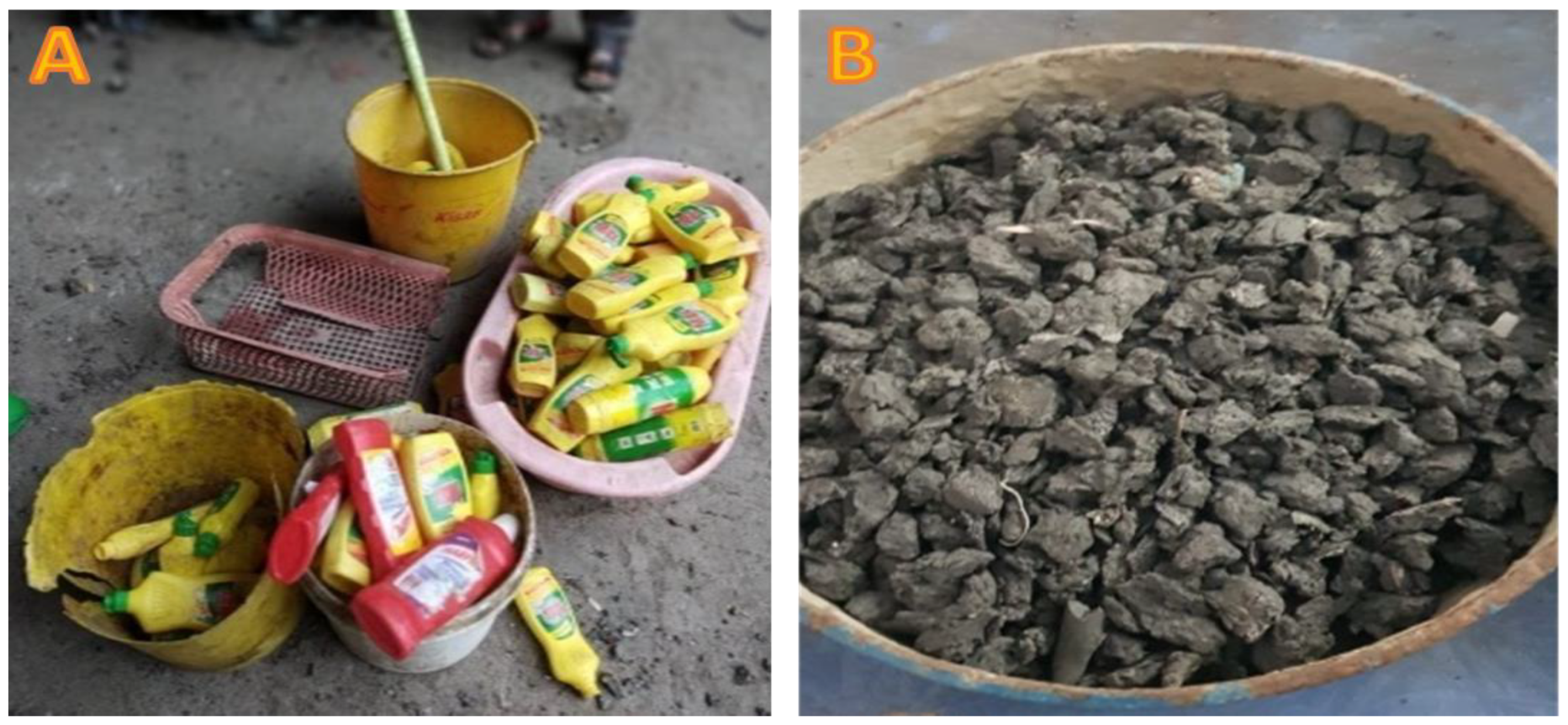
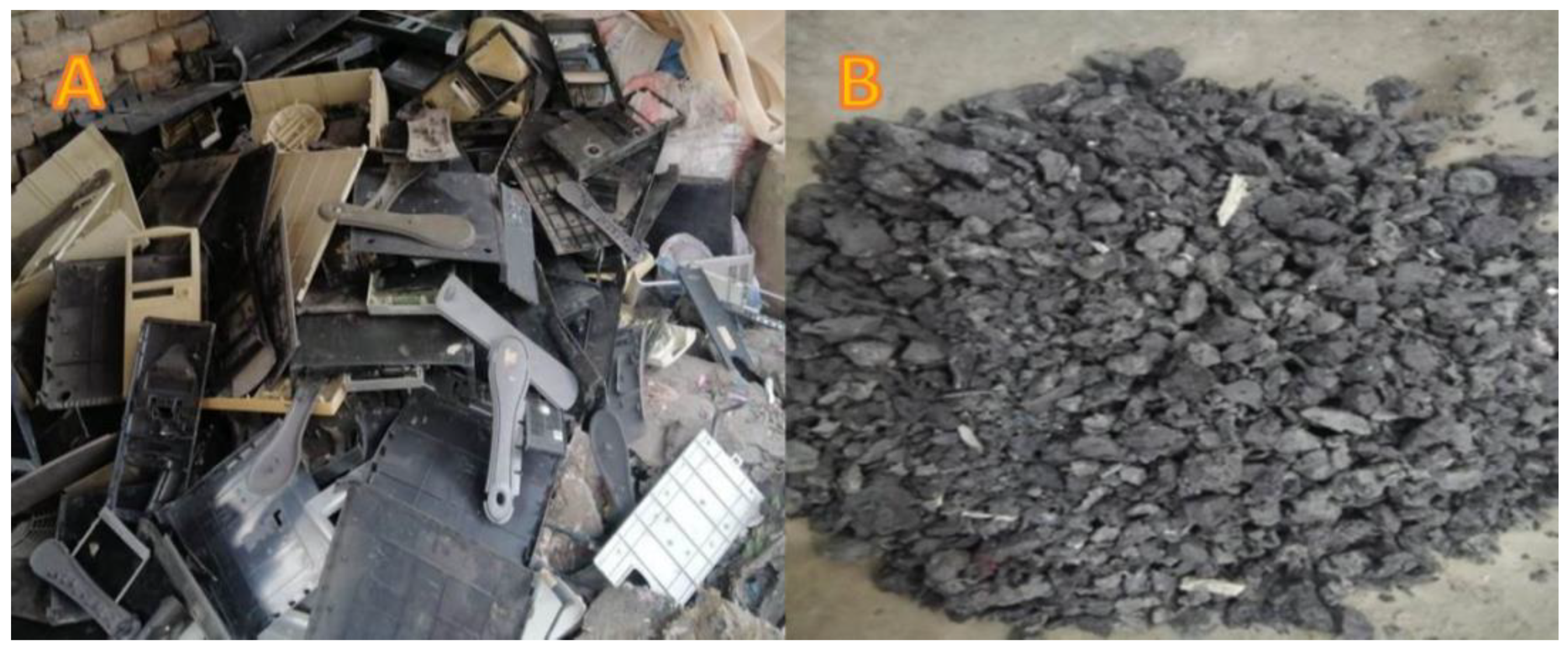
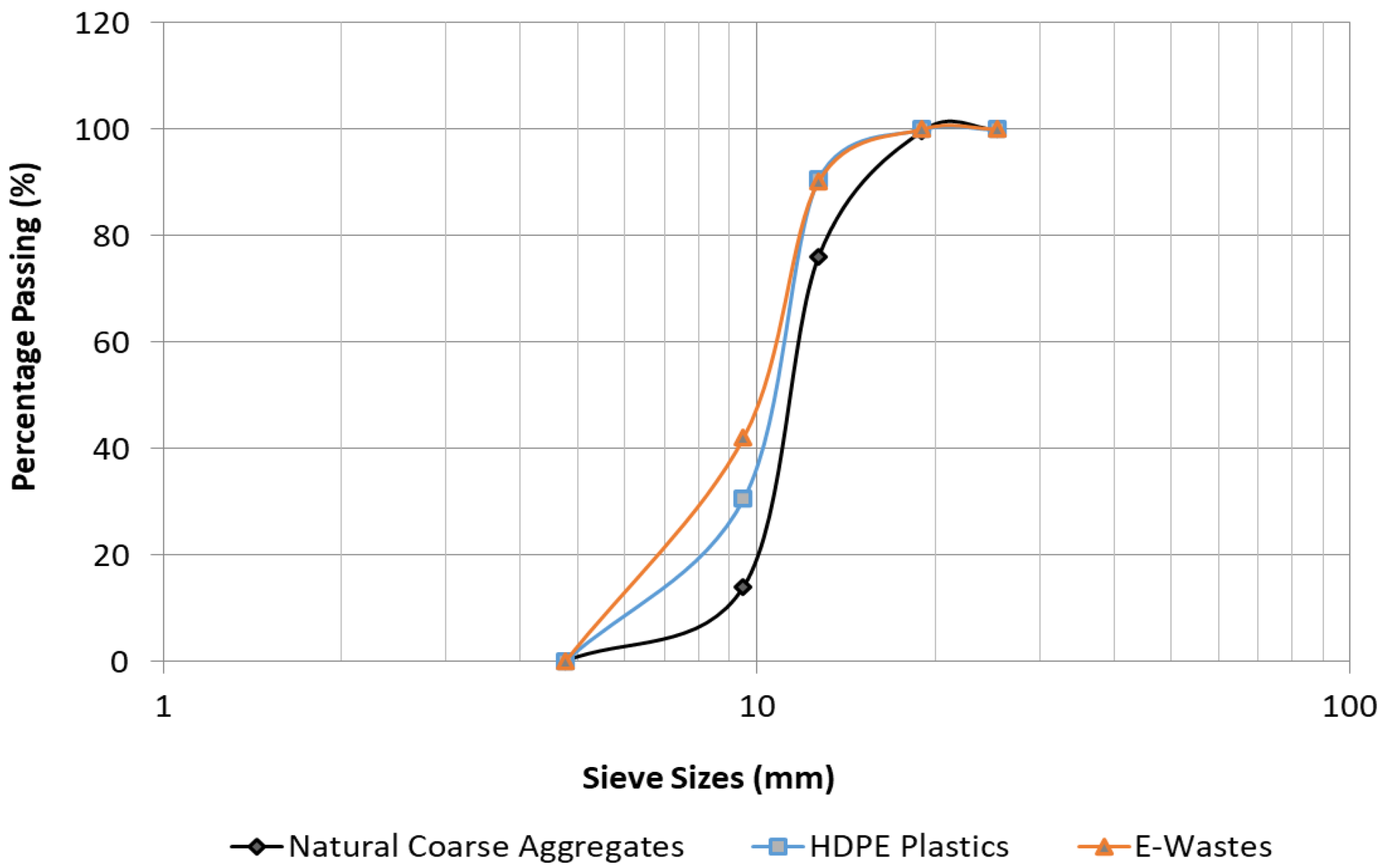
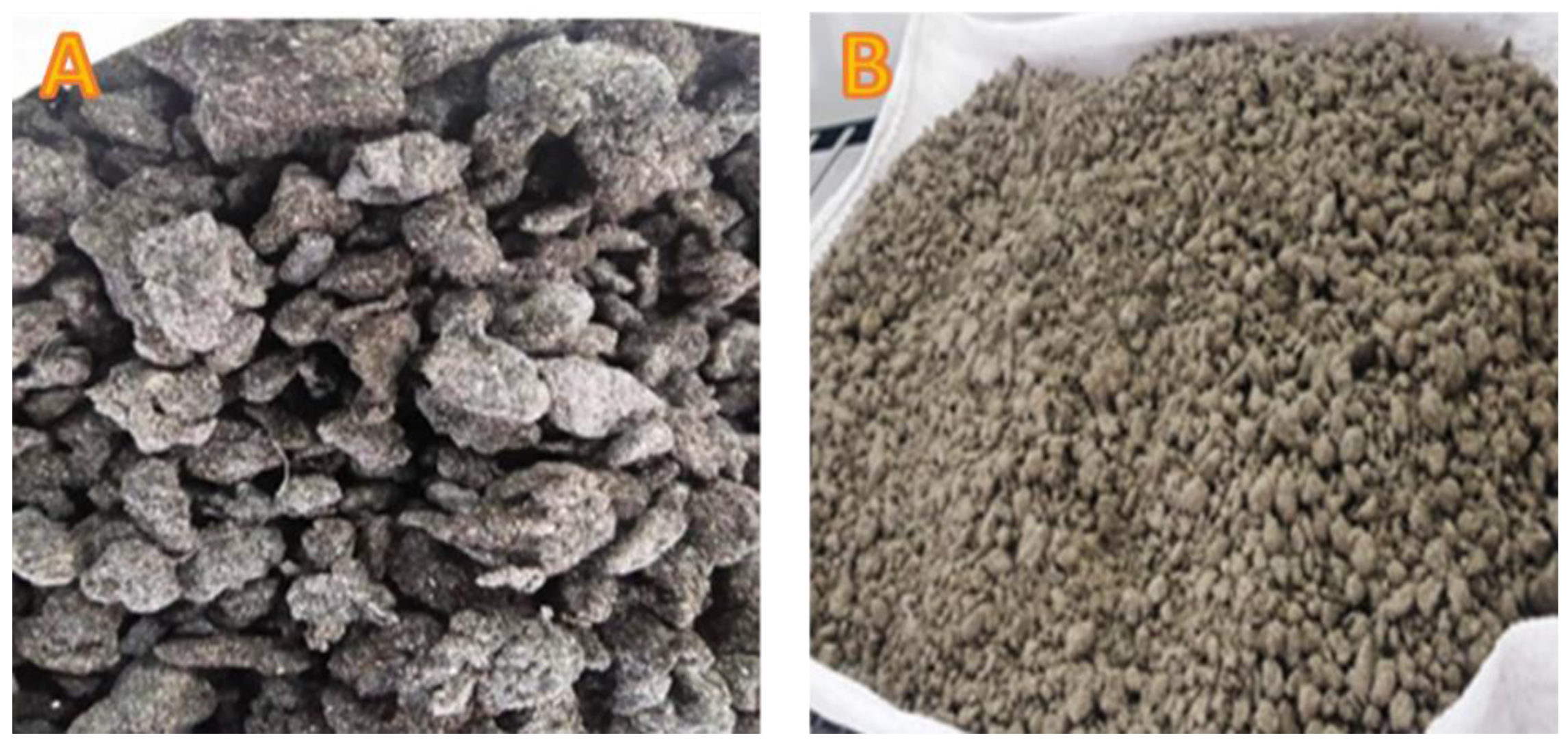
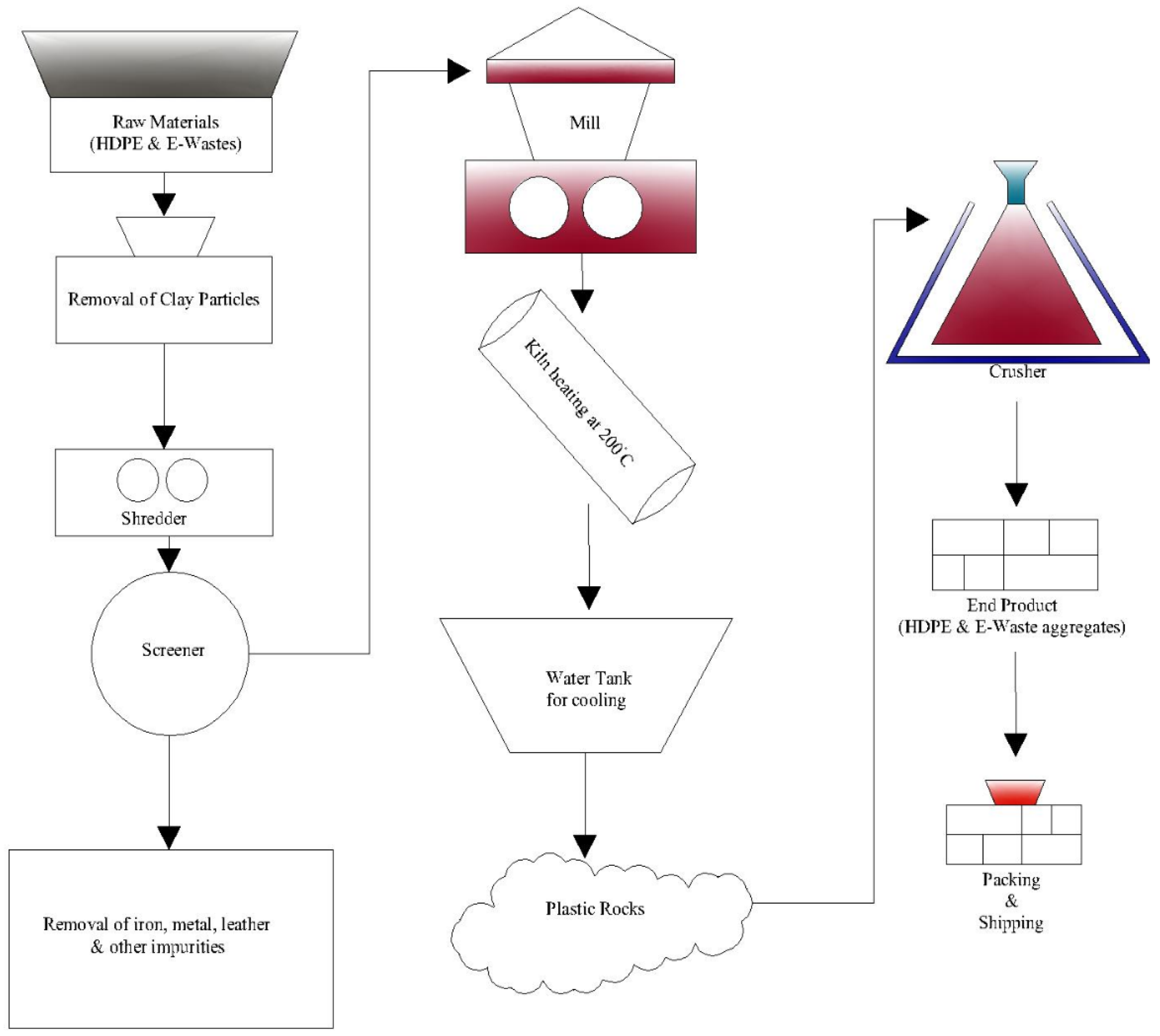
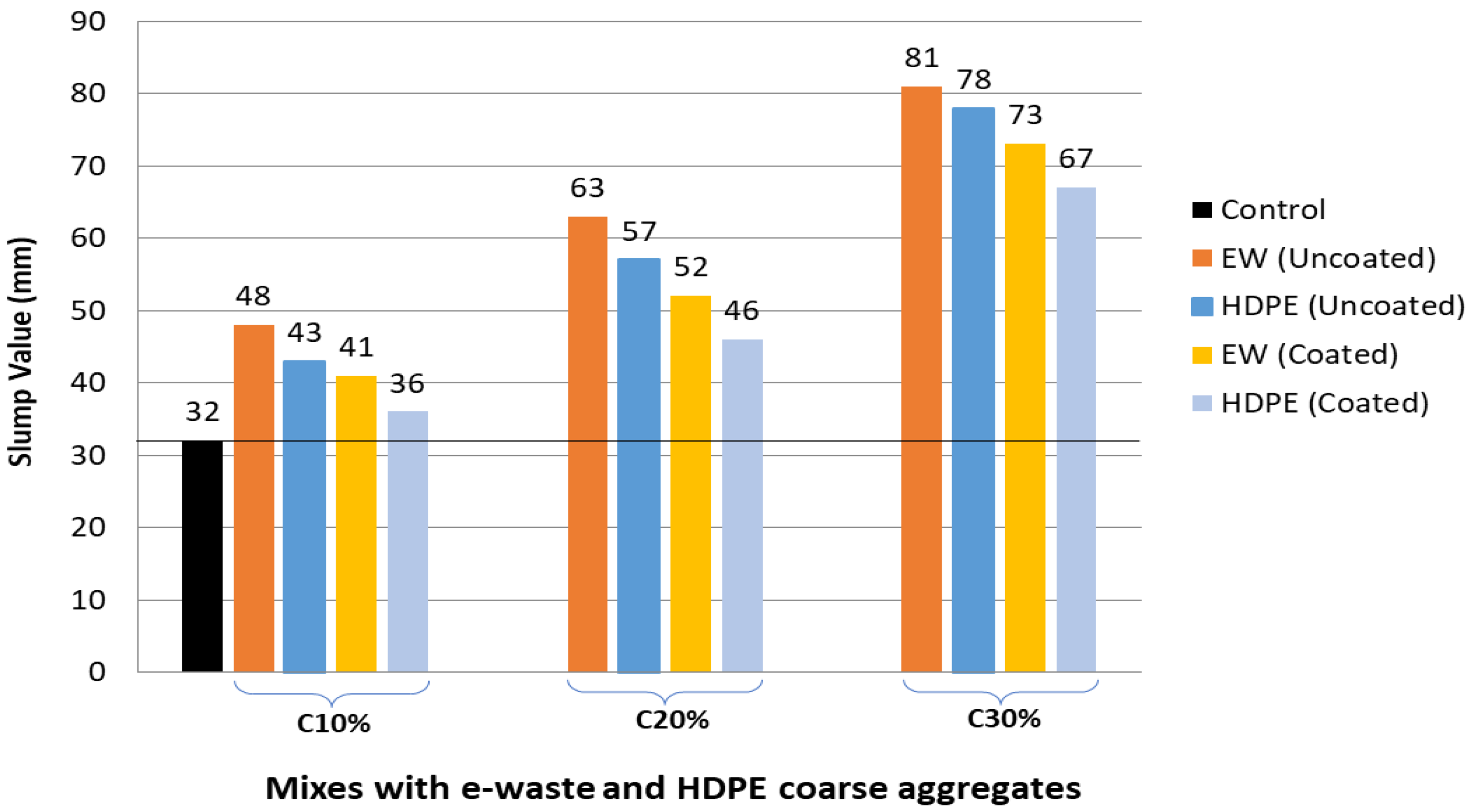
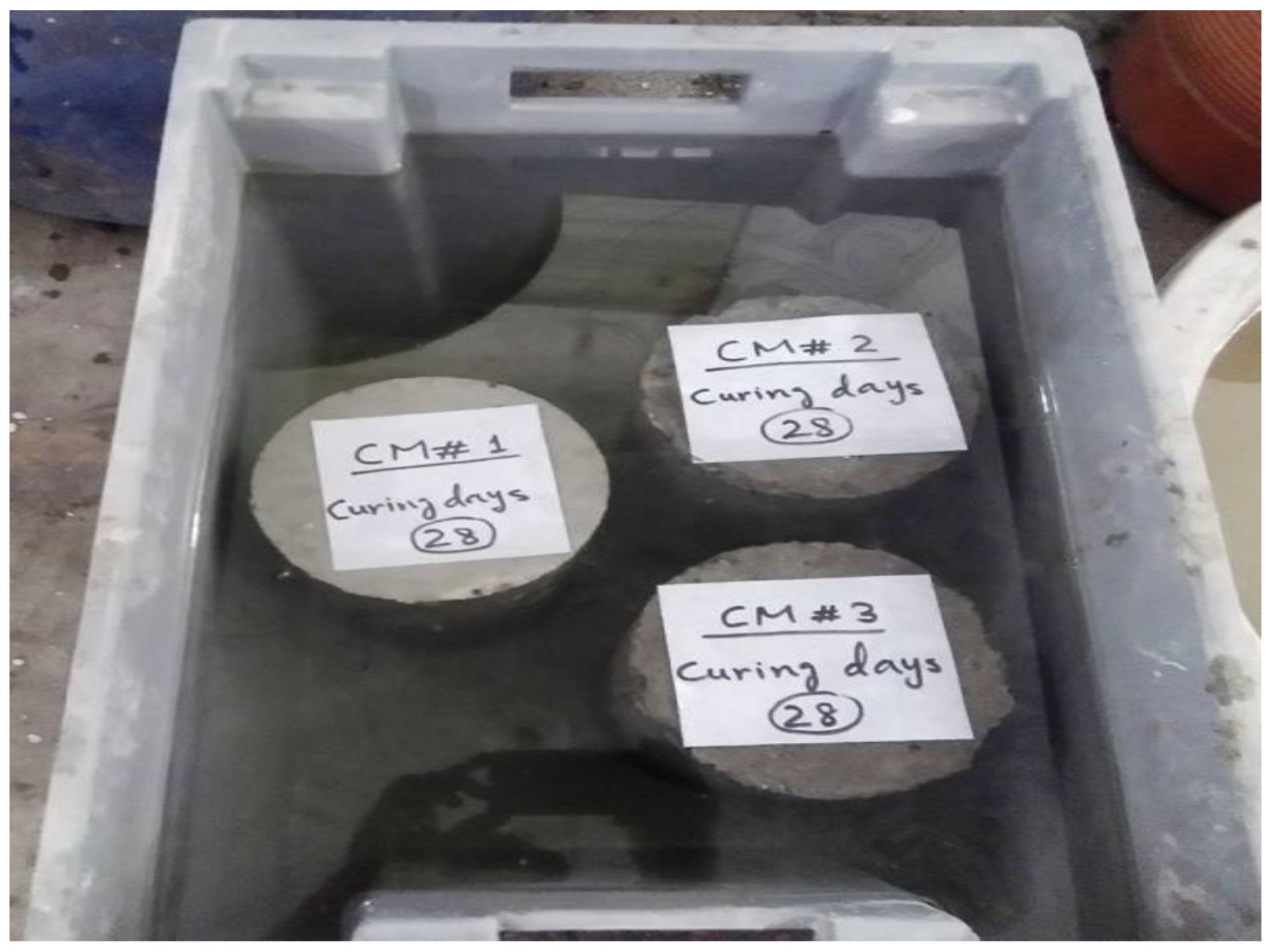

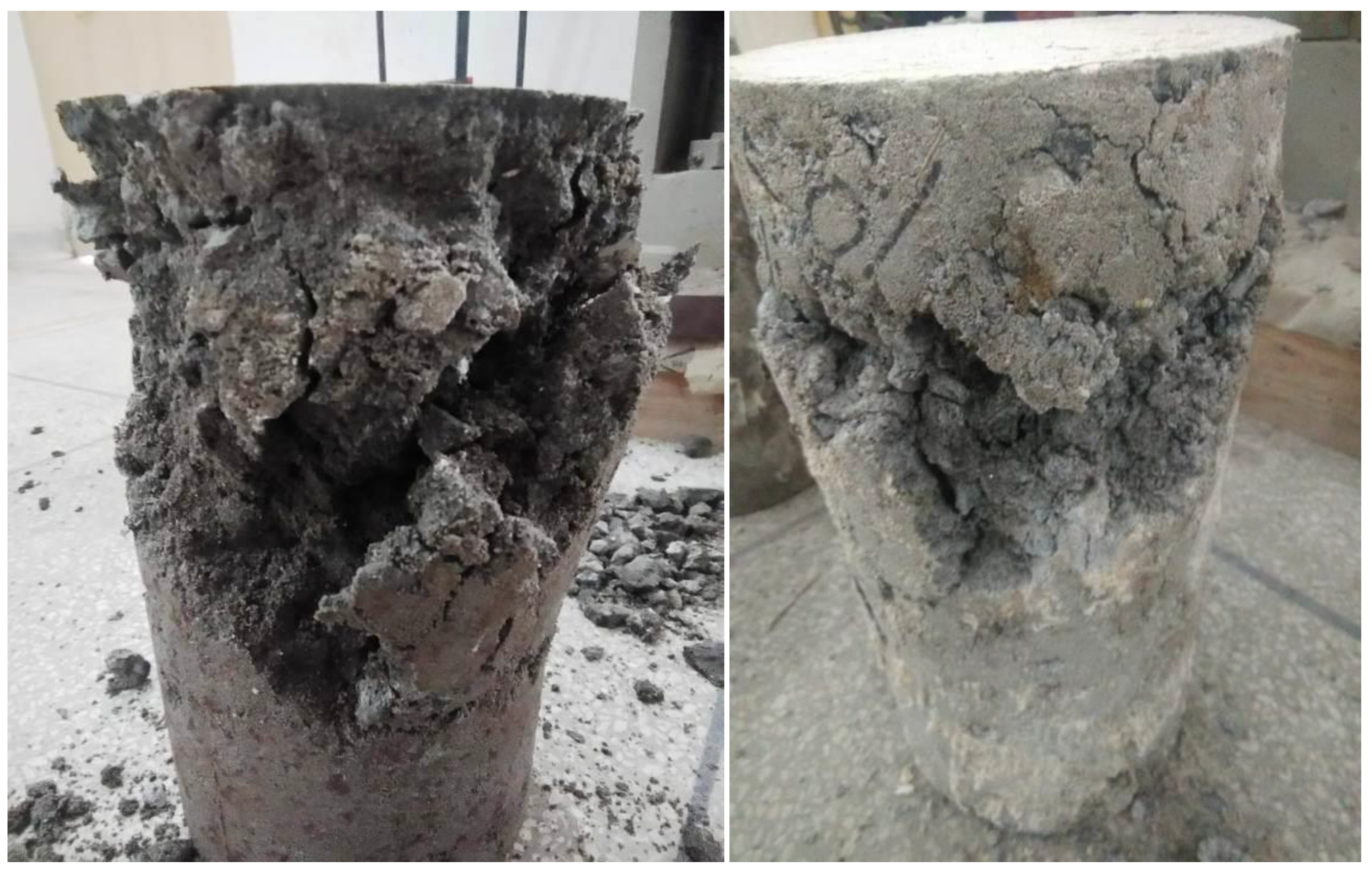
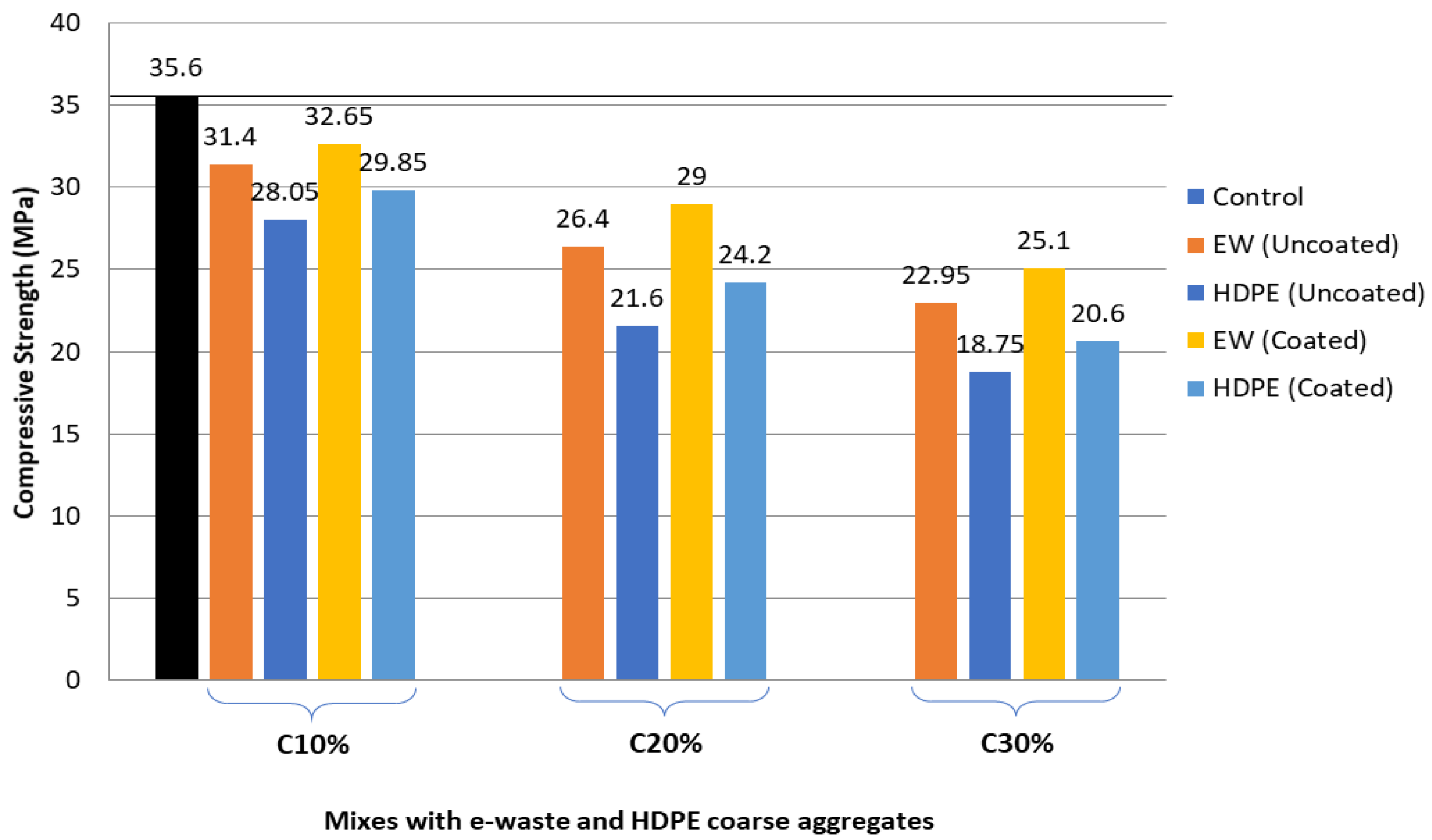
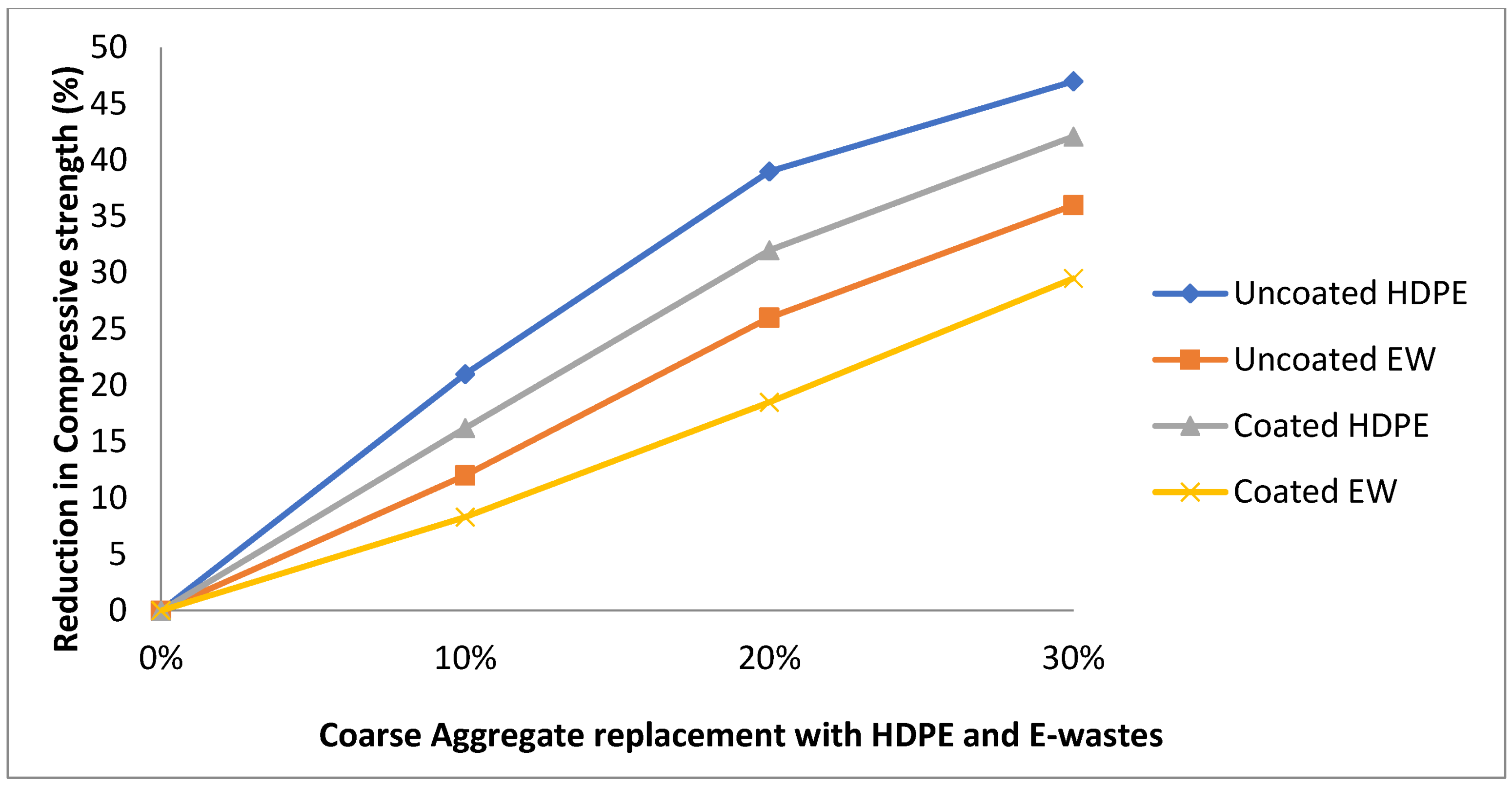
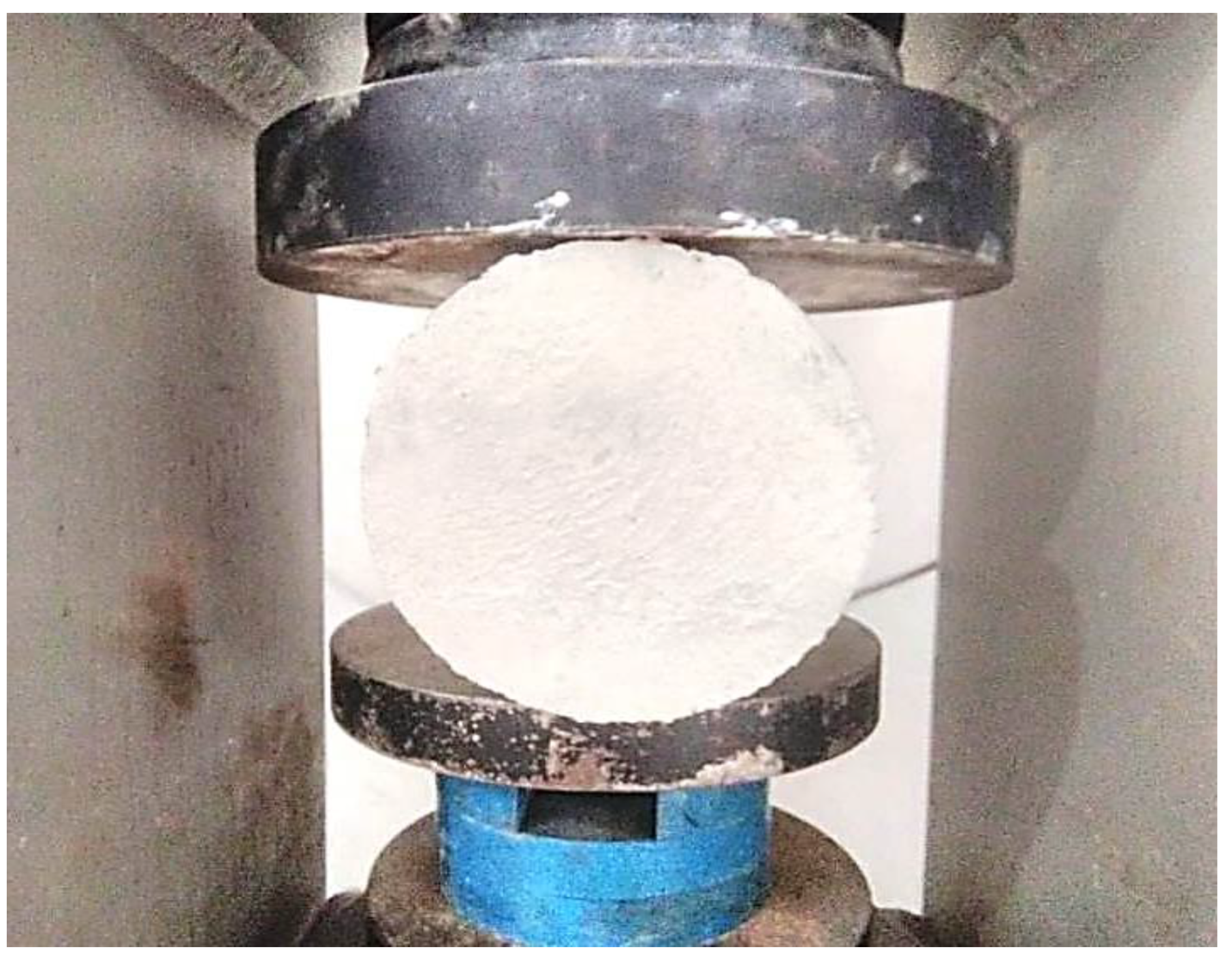
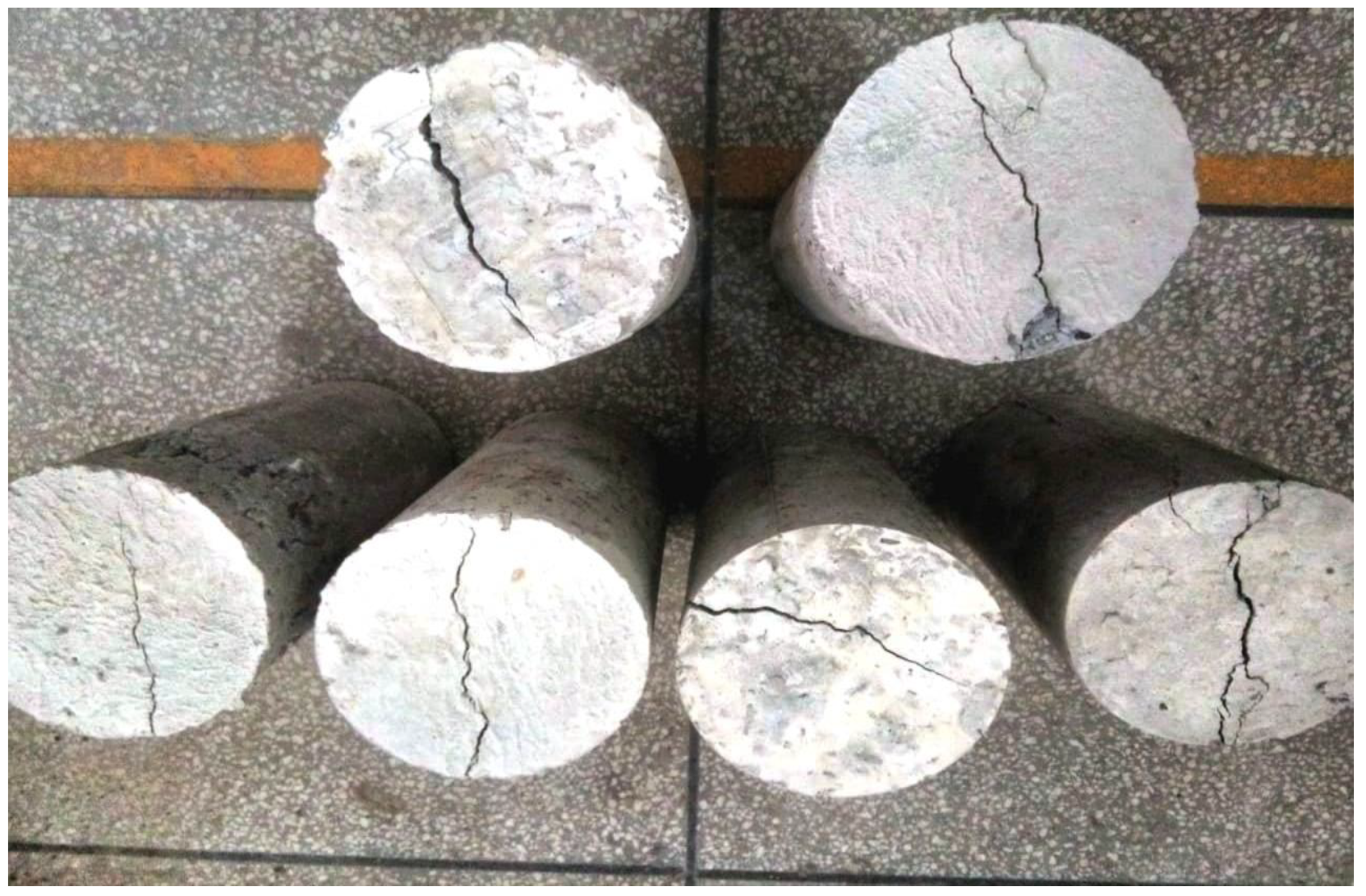
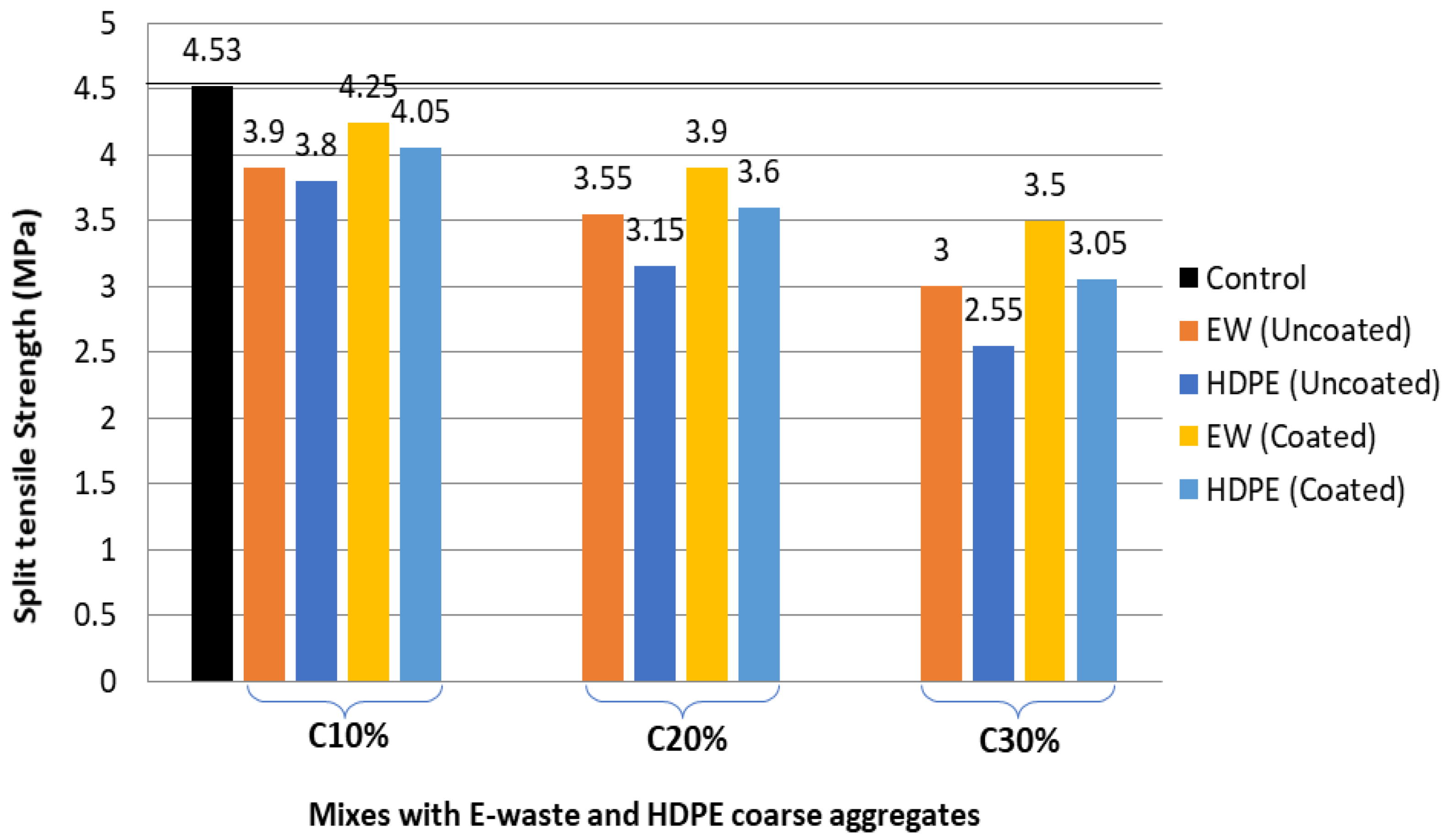
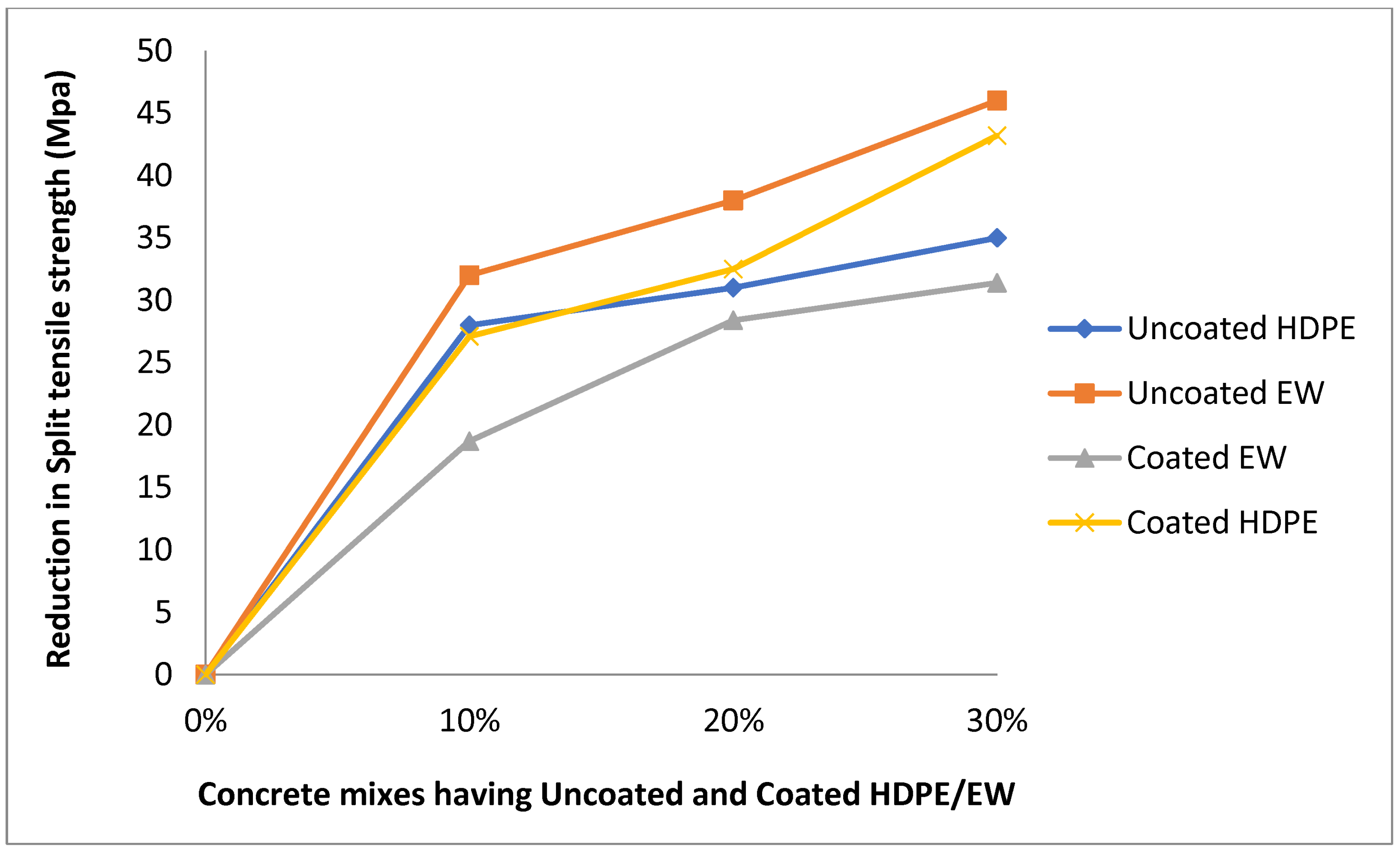
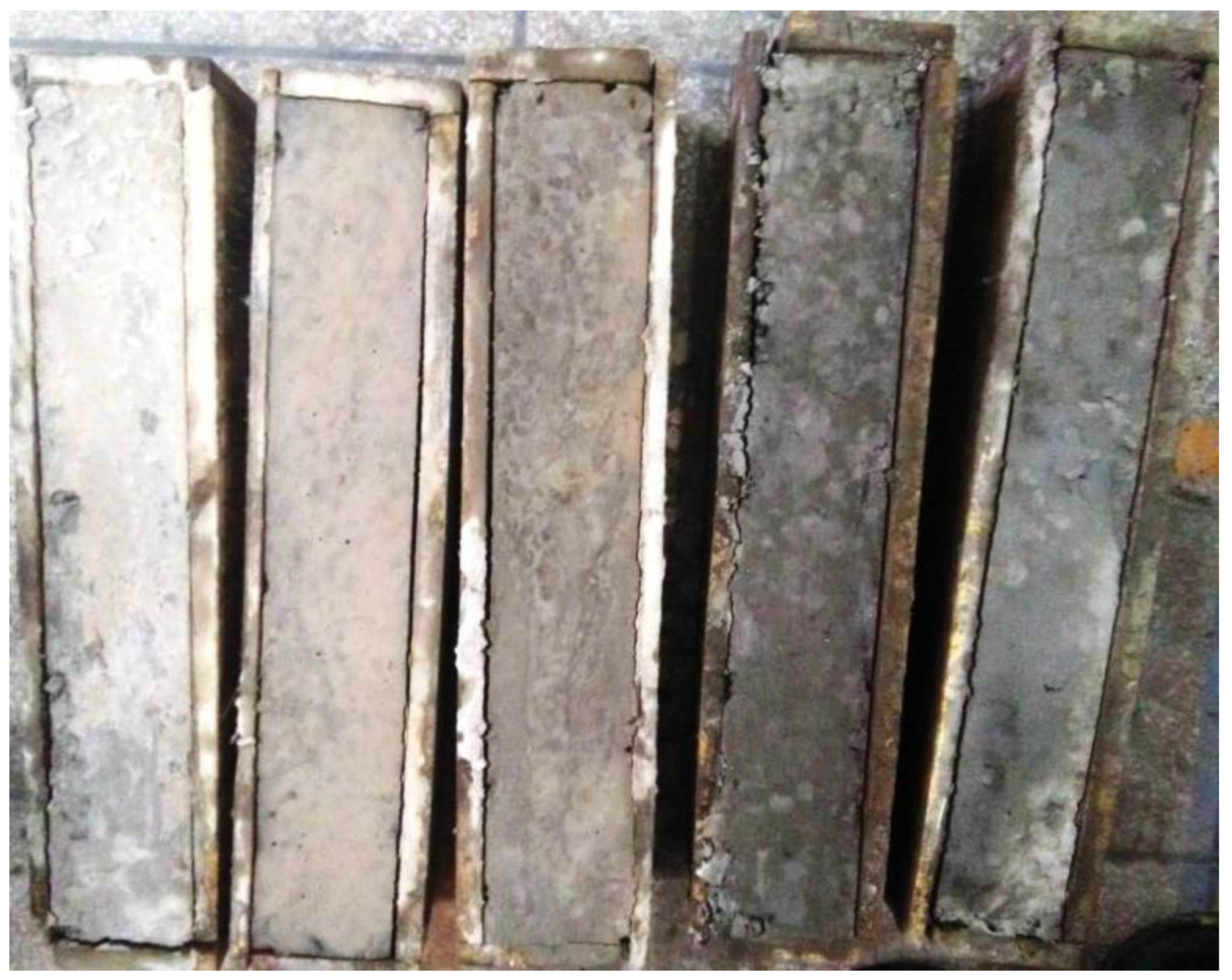
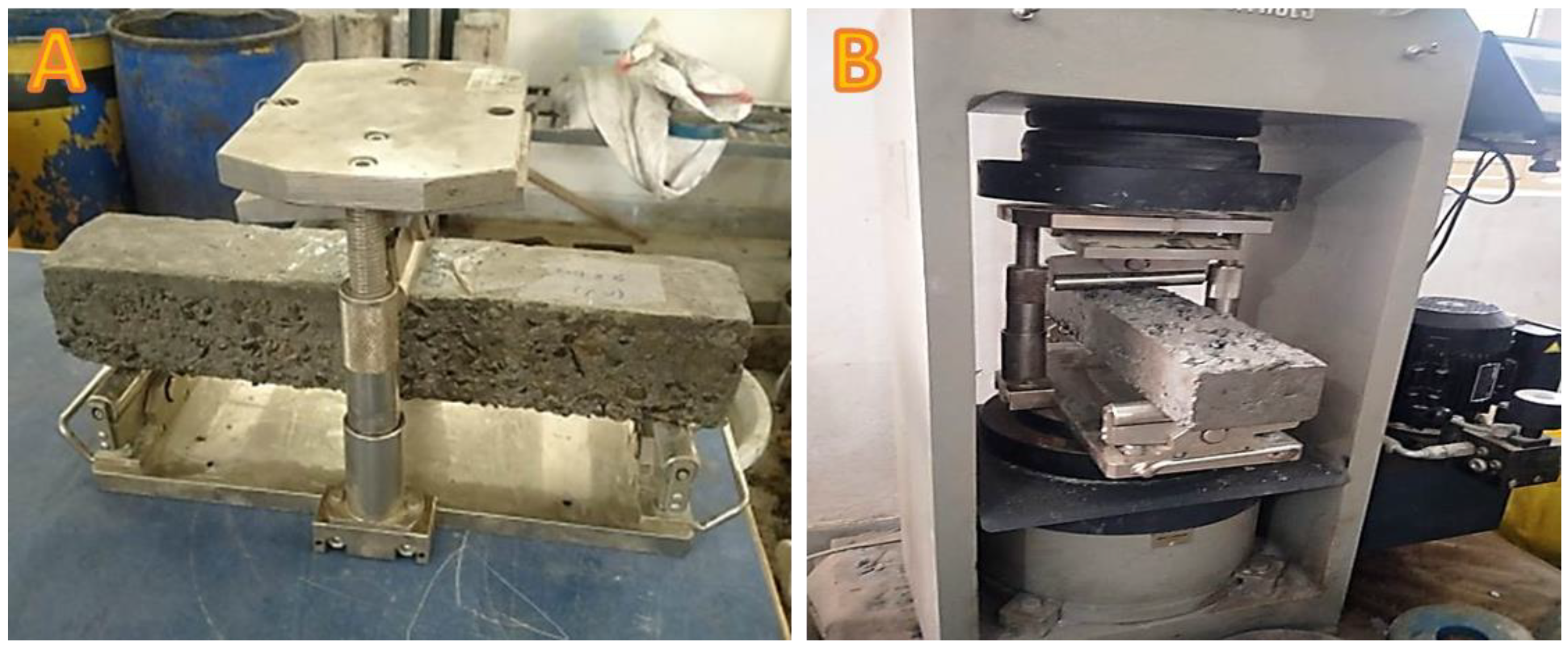


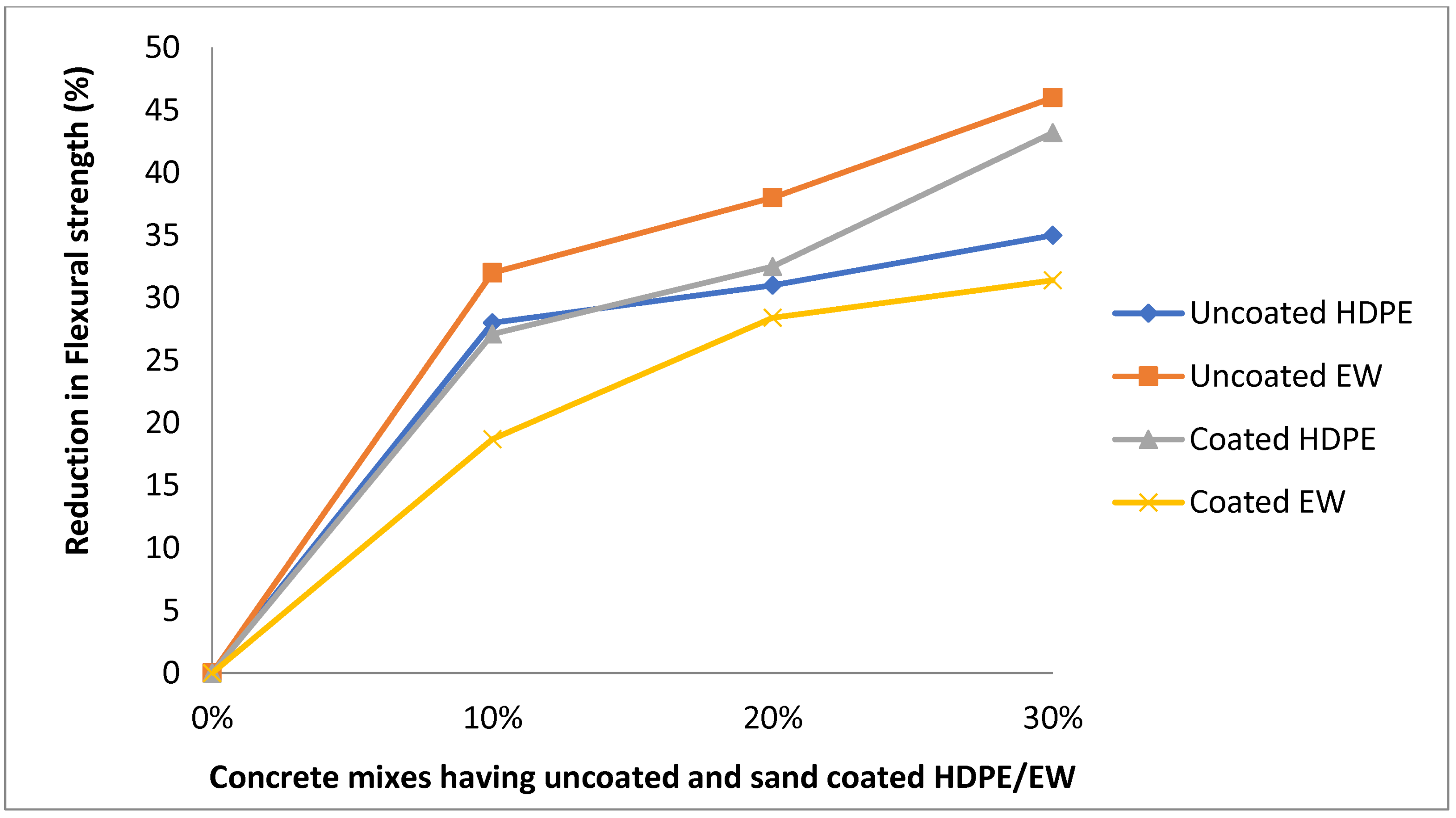
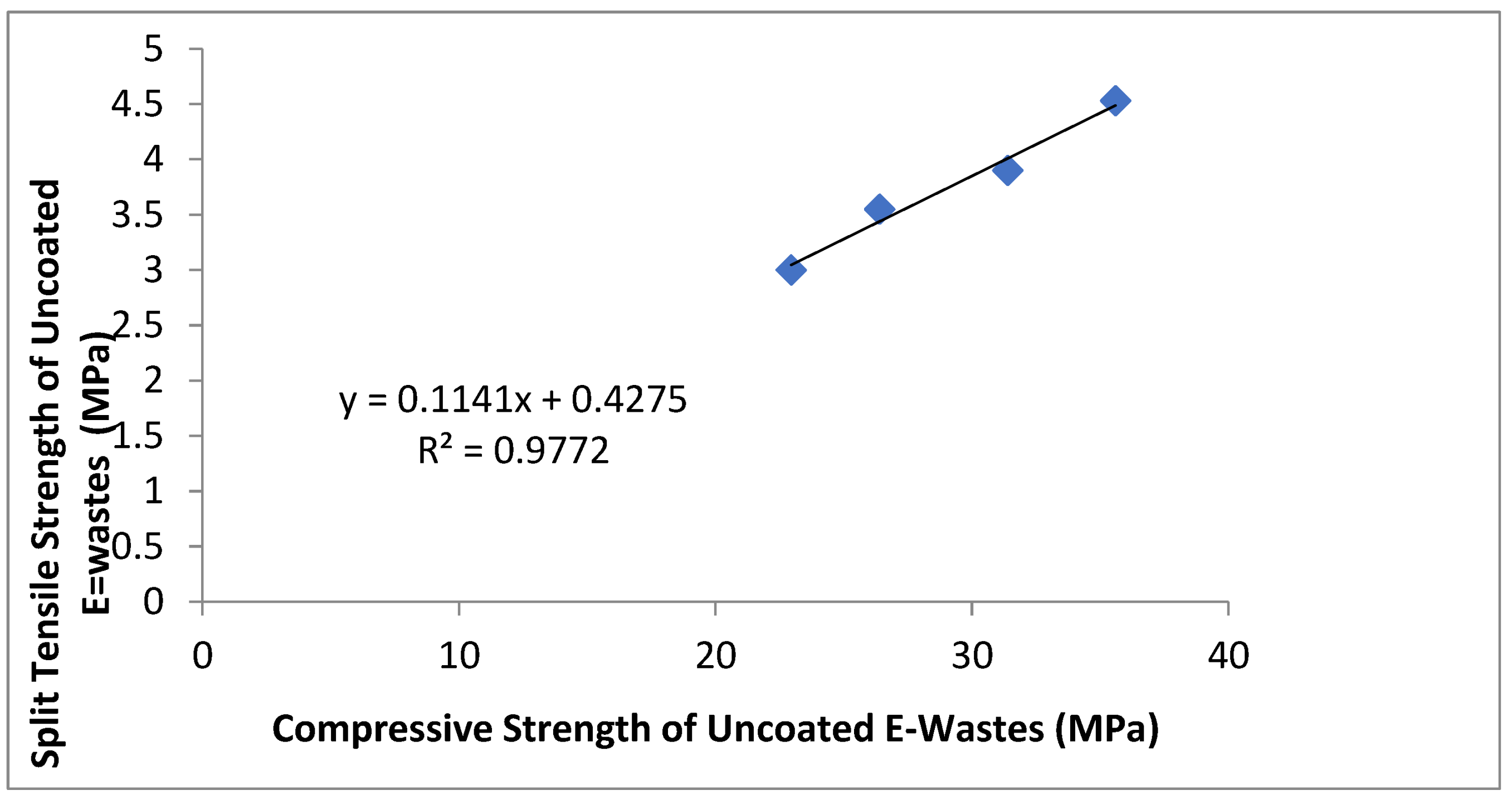
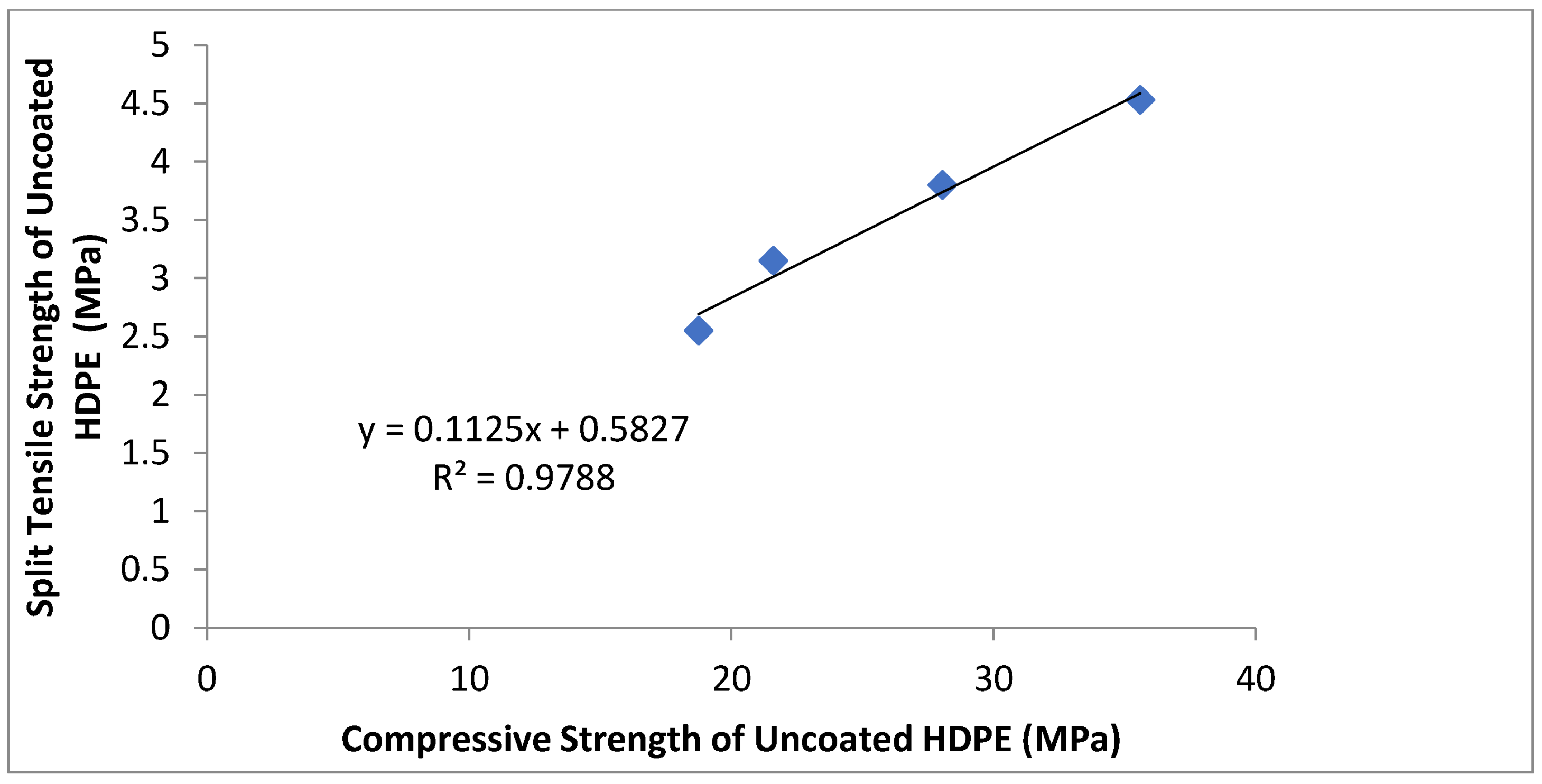
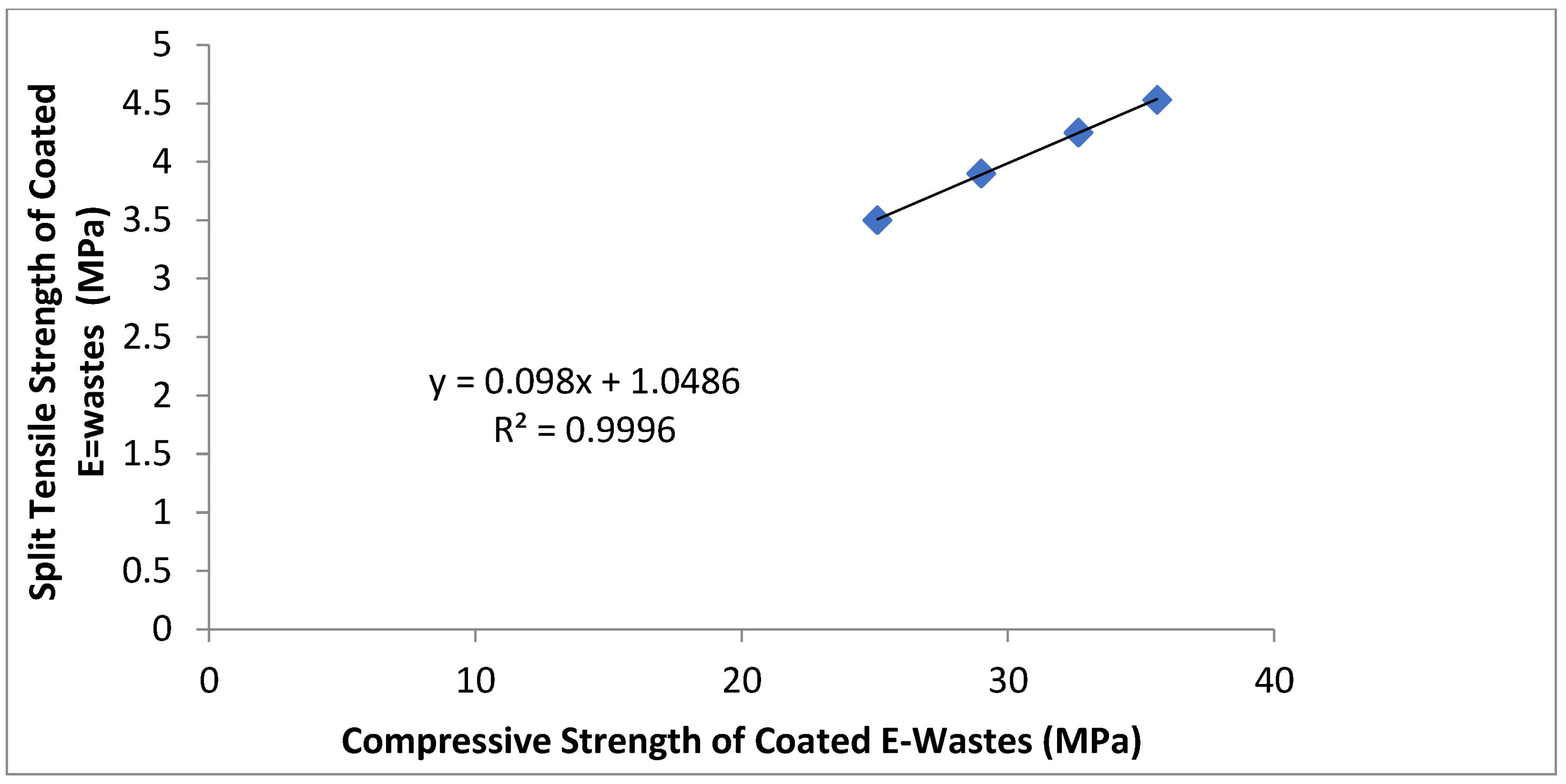
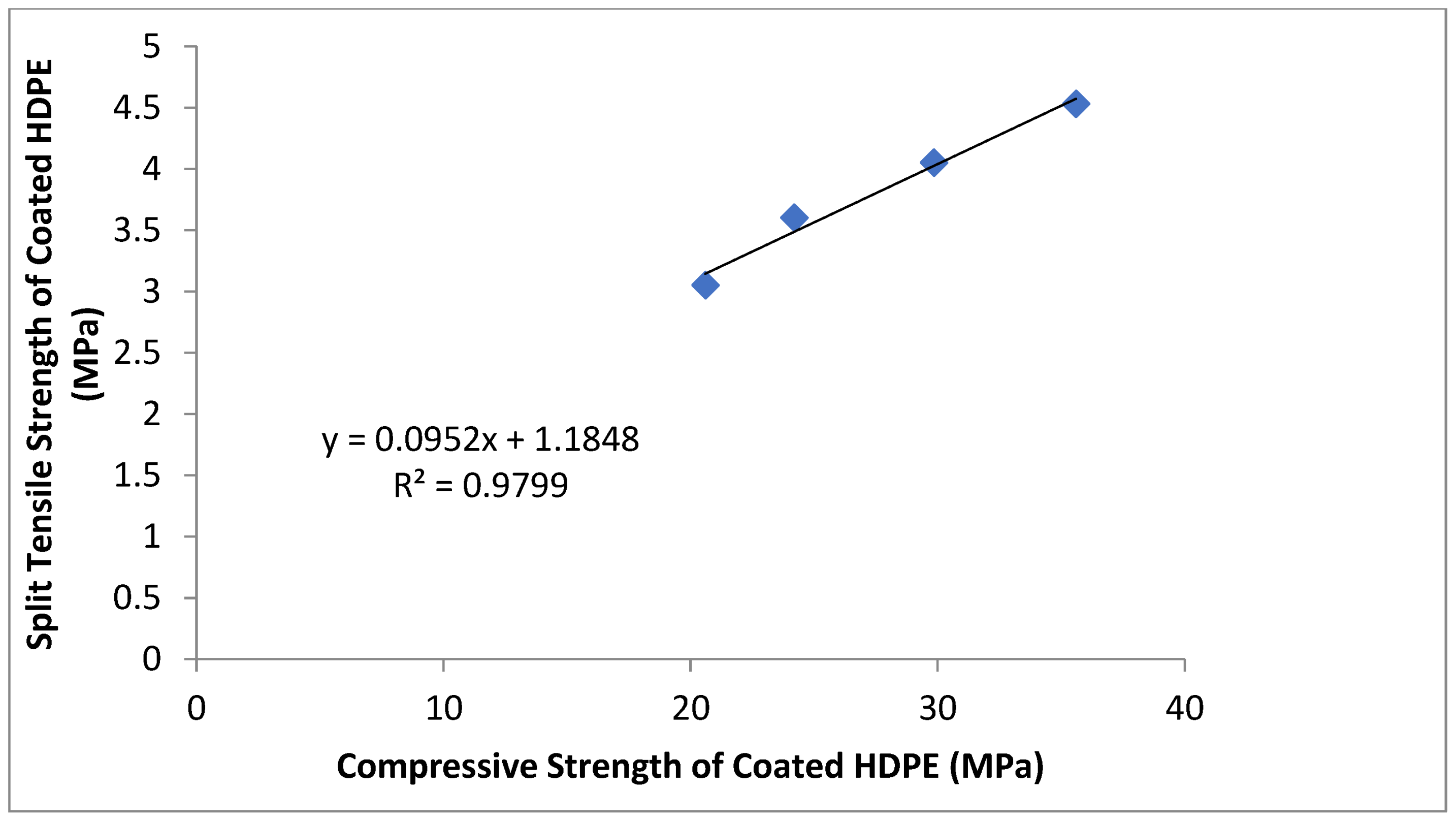
| Chemical Properties | Percentage (%) | Physical Properties | Result |
|---|---|---|---|
| SiO2 | 23.21 | Specific gravity | 2.49 |
| Al2O3 | 4.93 | Specific surface (m2/kg) | 320 |
| Fe2O3 | 3.87 | Consistency | 27% |
| CaO | 64.78 | Initial setting time | 89 min |
| MgO | 2.76 | Final setting time | 219 min |
| SO3 | 2.94 | Soundness | 8 mm |
| Na2O | 0.24 | Compressive strength (28-days) | 25.2 MPa |
| K2O | 0.78 | Fineness | 91.2% |
| Loss on ignition | 0.62 |
| Properties | Cement | Sand | Coarse Aggregate | HDPE | Electronic Waste | Super Plasticizer |
|---|---|---|---|---|---|---|
| Nominal Size Water Absorption | 50 μm - | −4% | 20 mm 4.75% | 20 mm 3.40% | 20 mm 3.40% | - - |
| Specific Gravity | 3.15 | 2.67 | 2.85 | 0.97 | 1.04 | 1.150 |
| Bulk Density (kg/m3) | 1440 | 1600 | 1602 | 531.6 | 476 | - |
| Fineness Modulus Morphology | 2.2 | 2.1 - | 1.79 - | 1.68 - | - Brown Liquid | |
| Abrasion Value | - | - | 1.32% | 7.24% | 6.68% | - |
| Impact Value Shape | - - | - - | 11.43% Angular | 2.66% Angular | 3.29% Angular | - - |
| Mix ID | Description | Cement | Natural Sand | Coarse Aggregate | Water | HDPE | E-Wastes | WetlockSealant | Plasticizer (SP-675) |
|---|---|---|---|---|---|---|---|---|---|
| (kg) | (kg) | (kg) | (kg) | (kg) | (kg) | (kg) | (kg) | ||
| Control | Reference Samples (Cylinders and beams) | 19.962 | 33.264 | 66.609 | 9.981 | 0 | 0 | 0.798 | 0.40 |
| C10%-EW | Replacement of 10% coarse aggregates with EW | 26.616 | 44.352 | 79.932 | 13.308 | 0 | 2.64 | 1.065 | 0.532 |
| C10%-HDPE | Replacement of 10% coarse aggregates with HDPE | 26.616 | 44.352 | 79.932 | 13.308 | 2.95 | 0 | 1.065 | 0.532 |
| C20%-EW | Replacement of 20% coarse aggregates with EW | 26.616 | 44.352 | 71.052 | 13.308 | 0 | 5.28 | 1.065 | 0.532 |
| C20%-HDPE | Replacement of 20% coarse aggregates with HDPE | 26.616 | 44.352 | 71.052 | 13.308 | 5.89 | 0 | 1.065 | 0.532 |
| C30%-EW | Replacement of 30% coarse aggregates with EW | 26.616 | 44.352 | 62.172 | 13.308 | 0 | 7.91 | 1.065 | 0.532 |
| C30%-HDPE | Replacement of 30% coarse aggregates with HDPE | 26.616 | 44.352 | 62.172 | 13.308 | 8.84 | 0 | 1.065 | 0.532 |
| Test Type | Standard Used | Specimen Shape | Age (Days) | No. of Samples | |||
|---|---|---|---|---|---|---|---|
| HDPE and E-wastes (Uncoated and Coated) | |||||||
| 0% | 10% | 20% | 30% | ||||
| Slump | ASTMC143/C143M [33] | Cone | Immediately after mixing | 3 | 6 | 6 | 6 |
| Compressive strength | ASTMC39/C39M [34] | Cylinder | 28 | 3 | 12 | 12 | 12 |
| Split Tensile Strength | ASTMC496/C496M-17 [35] | Cylinder | 28 | 3 | 12 | 12 | 12 |
| Flexural Strength | ASTMC239 [36] | Cylinder | 28 | 3 | 12 | 12 | 12 |
Publisher’s Note: MDPI stays neutral with regard to jurisdictional claims in published maps and institutional affiliations. |
© 2022 by the authors. Licensee MDPI, Basel, Switzerland. This article is an open access article distributed under the terms and conditions of the Creative Commons Attribution (CC BY) license (https://creativecommons.org/licenses/by/4.0/).
Share and Cite
Abbas, S.N.; Qureshi, M.I.; Abid, M.M.; Tariq, M.A.U.R.; Ng, A.W.M. An Investigation of Mechanical Properties of Concrete by Applying Sand Coating on Recycled High-Density Polyethylene (HDPE) and Electronic-Wastes (E-Wastes) Used as a Partial Replacement of Natural Coarse Aggregates. Sustainability 2022, 14, 4087. https://doi.org/10.3390/su14074087
Abbas SN, Qureshi MI, Abid MM, Tariq MAUR, Ng AWM. An Investigation of Mechanical Properties of Concrete by Applying Sand Coating on Recycled High-Density Polyethylene (HDPE) and Electronic-Wastes (E-Wastes) Used as a Partial Replacement of Natural Coarse Aggregates. Sustainability. 2022; 14(7):4087. https://doi.org/10.3390/su14074087
Chicago/Turabian StyleAbbas, Syed Nasir, Muhammad Irshad Qureshi, Malik Muneeb Abid, Muhammad Atiq Ur Rehman Tariq, and Anne Wai Man Ng. 2022. "An Investigation of Mechanical Properties of Concrete by Applying Sand Coating on Recycled High-Density Polyethylene (HDPE) and Electronic-Wastes (E-Wastes) Used as a Partial Replacement of Natural Coarse Aggregates" Sustainability 14, no. 7: 4087. https://doi.org/10.3390/su14074087
APA StyleAbbas, S. N., Qureshi, M. I., Abid, M. M., Tariq, M. A. U. R., & Ng, A. W. M. (2022). An Investigation of Mechanical Properties of Concrete by Applying Sand Coating on Recycled High-Density Polyethylene (HDPE) and Electronic-Wastes (E-Wastes) Used as a Partial Replacement of Natural Coarse Aggregates. Sustainability, 14(7), 4087. https://doi.org/10.3390/su14074087








